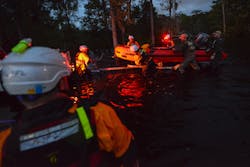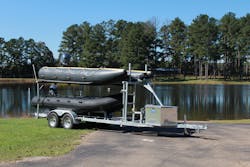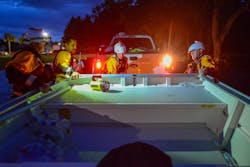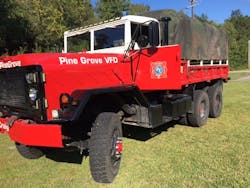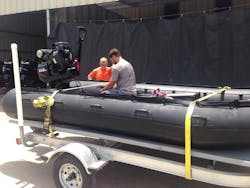It seems that there has never been so great a need for diverse and capable water rescue resources as there has been in recent years. In much the same way that lives and property have become more at risk from fire in the wildland/urban interface, so too have people become at risk near water.
People want to live where they play—by lakes, rivers, streams and oceans. The National Oceanic and Atmospheric Administration (NOAA) predicts that by 2020, nearly half of the U.S. population will live on or near the coast. As this trend continues, so too does the public’s expectation that fire and emergency services can provide timely and professional responses for all the times when people failed to evacuate, were surprised and unable to escape, or simply did not turn their vehicle around in a flooding situation.
An evolving mission
More events would continue to shape USAR’s evolving water mission. In 2008, hurricanes Ike and Gustav led to extensive deployments with widespread water-rescue operations in Louisiana and Texas. In 2013, flooding in Boulder County, CO, resulted in extensive swiftwater rescue operations.
The national USAR system had begun to see the value of swiftwater rescue capabilities within the teams, and many teams were investing in training and resources to address this more frequent challenge. Many of these new capabilities would be tested again in the Carolinas in the wake of Hurricane Matthew in 2016. Many excellent rescues and operations were executed by USAR teams exercising their newly broadened capabilities.
After years of work and development, a new Water Rescue Concept of Operations was accepted in 2016, and the national USAR system full expanded its mission to include surface and swiftwater rescue. This shift increased the number of inflatable rescue boats (IRBs) in the system, and required more training, personal PPE, rescue equipment, trailers and even recurrency watermanship testing.
One of the biggest national tests of widespread swiftwater and flood rescue came with Hurricane Harvey in 2017. The city of Houston saw extensive flooding that ebbed and flowed, moving around the city, affecting hundreds of thousands of people. The response constituted one of the most extensive water deployments in the national USAR system.
Fortunately, it seems the entire rescue community is more invested in building, sharpening and refining water rescue capabilities. Now, more than ever, smaller and lighter water Mission-Ready Packages (MRPs) are deployed to assist local jurisdictions with their needs. This is taking place from a local to a national level and ranges from volunteer fire departments to National Guard units. It is fascinating to watch so many new tools and techniques being added to our water rescue “arsenal.” Here I hope to share some lessons that can be applied at the most basic level to the most complicated and widespread water deployment.
Tools of the trade
So, what does a fully stocked and well-rounded arsenal of water rescue resources look like? Aluminum jon boat-type rescue boats, IRBs, mission-appropriate boat motors, “walk-beside” or wading boats, highwater vehicles, rotary wing aircraft, and a logistical support element to name a few. Commanders and field leaders should be quick to identify what tool is best suited for the missions. Many of these come with pros and cons.
Jon boats
Jon boats are great rescue and recovery vessels in surface water and some flood environments, but their limitations must be understood by commanders as well as boat operators. Many of these craft have drop-down dive platforms, center console steering, storage compartments, and the capability of side-scan sonar. Their rigid aluminum body also makes them resistant to puncture and intrusion. These boats are great long-term investment if well cared for and maintained.
Although the proliferation and availability of jon boats for rescue use is the most extensive, they are typically ill-suited for swiftwater work. Consider the use of aluminum boats for swiftwater rescue work as a last resort. Multiple times a year, we see news articles detailing how rescue boats were capsized while performing rescues, body recoveries, or just surveying and traveling in the urban swiftwater environment. These incidents have resulted in deaths, injuries, extensive litigation and, in some cases, prosecution.
Many incidents seem to happen when these boats are overloaded, operating in current, become pinned in current, and especially around dams. These boats lack the stability and have a much narrower center of gravity than most IRBs. They also lack buoyancy and the ability to shed water quickly. As such, jon boats are optimized on lakes, flooded areas with minimal current, and areas likely to puncture IRBs, but not good for swiftwater conditions.
Pros Cons
Puncture-resistant Unstable in swiftwater
Storage Lack buoyancy
Side-Scan Sonar Lower weight rating/payload
Drop-down dive/recovery platforms Portability/weight
Long service life Inability to shed water
IRBs
Naturally, IRBs are well suited to swiftwater environments. A quality IRB should feature several important components: It should be constructed of durable material, such as Hypalon, Neoprene or Polyurethane, and the boat should be constructed of multiple champers with durable fill-points as well as pressure-relief valves. One big advantage to IRBs is their buoyancy. Smaller IRBs range from a 2,000-lb. rating to larger 14-foot craft that can float a whopping 5,000 lbs. Their ability to stay afloat and support these loads is not compromised, even if the boat flips. Additionally, most quality IRBs have large scuppers or are self-bailing to allow water to quickly escape the boat. Plugs or 1-inch trap valves will not be able to drain water quickly enough. An IRB is vulnerable when full of water because the center of gravity is lowered, and the risk of flipping is increased. Our pontoon-style IRB has two 3-inch scuppers, and it can nose-under a wave and a rapid overfilling the boat. I have watched water literally spilling over the transom, but if you hold the boat steady upriver and increase the throttle, the water evacuates in 10 to 15 seconds.
A key consideration for IRBs is boat shape. Are you looking for a military-style boat that is fully enclosed by the sponson tubes and the transom, or are you open to a pontoon-style craft with an open front? The military style is very common and offers some interchangeable parts and training interoperability. The V-style keel does make the military-type craft less stable in turbulent and pitchy water. The pontoon-style craft lends itself to a flatter and wider base, lowering the boat’s overall center of gravity and making the boat stable in pushy water. It is for this reason you will see so many boats of this type in the Grand Canyon and the New River Gorge, and deployed by the National Park Service. The front of these craft are open, low and conducive to recovering patients and rescuers. Both boat styles have their applications and a place in swiftwater rescue.
Pros Cons
Buoyancy/personnel capacity Susceptible to puncture
Stability Shorter service life
Ability to shed water Limited storage (lashing, bags, nets)
Walk-beside boats and highwater vehicles
In conjunction with other, powered IRBs and high-water vehicles, walk-beside boats can be an excellent option as part of a large-scale strategy for a neighborhood and multi-family housing evacuations. Our team used this technique in the Houston suburbs during Hurricane Harvey. As the military was not yet in our area, we used large debris dump trucks with no tail gates as casualty collection points. Walk-beside boats, and other types of boats, would collect people from their houses. They would meet the high-water truck in waist-deep water on a neighborhood thoroughfare. Once the truck was loaded, it would make a trip to the nearest shelter and return. This was an excellent strategy because it maximized every tool’s potential. Boats did not have to risk driving in the shallows to the water line in order to drop off their evacuees.
Rotary wing aircraft
Many progressive teams have been assembled and deployed using military aircraft and air crews combined with fire and rescue helicopter search-and-rescue technician (HSART) recue swimmers. Texas and the Carolinas are just some examples of mature and successful programs. The helicopter has become a great asset and a much lower-risk option than traditional methods. This is only the case, however, if the program is a well-oiled machine. This usually happens by ensuring the right crews are selected for duty. Then initial and recurrency training is progressive and aggressive. The benefits are great, but this is a high-consequence program.
That being said, in Texas, I would discard the old paradigm, Reach-Throw-Row-Go-Helo, and heavily consider Reach-Throw-Helo-Row-Go when appropriate. Helicopter hoist options can be much safer, predictable and reliable than deploying boats and rescue swimmers in untenable swiftwater environments. HSART crews can be utilized not only for rescues and hoisting, but they can provide recon for boat crews and other ground assets. They can even provide close air support, serving as a “downstream safety” for boat crew and water techs when other means are not feasible. This is fast becoming the new normal. Most of our European rescue counterparts are shocked at how long it has taken us to see the value and potential of rotary wing rescue systems.
One asset at a time
Climb mountains one step at a time. Your program may not have access to every weapon and tool right away. The first step is to identify both the strengths and the gaps in your response capability. Identify alternative resources, such as neighboring jurisdiction, the Emergency Management Assistance Compact (EMAC) system, and partners, such as the military and public works. Wisdom is having a firm grasp on what your team is capable of and where its limitations must lead to heightened risk in decision-making.
The next step is making a plan to get to the level that is required to adequately protect and respond. An armada or fleet starts with one boat. Just be aware that each boat has some great benefits, but they all have an Achilles heel. It is incumbent to balance one resource with certain limitations with another that has those strengths.
The final step is in the fight, during the storm and flooding. Choose very judiciously which tool best fits the risk profile and the mission. If you are a hammer, everything looks like a nail. This is a dangerous example of tunnel vision. Know what boat or other asset can best be utilized to ensure a positive outcome for the citizens in our care.
Sidebar: Boat Motors
The early phase of choosing a motor might entail four stroke versus two stroke. Then, generally speaking, one needs to investigate whether their outboard motor should be prop or jet drive. Does your boat’s transom necessitate a long or short shaft motor? If you select a conventional outboard with a prop, what pitch and how many blades will serve you best?
Our boats operate in trashy floodwater and aerated swiftwater. The stock aluminum three-blade props experienced cavitation, or loss of power, in frothy, aerated swiftwater. This led us to try props with less speed and more torque. Currently, we have landed on four-blade props with around an 11 pitch.
Another issue among responders and boat experts is steel vs. aluminum props. One side of the aisle says aluminum props will shear off and save the motor/lower end of the motor. The other says in a prop strike in a true rescue, steel will possibly damage the motor, but your prop will remain viable enough to propel the boat and its occupants to a safe area.
Our best performing props are steel, four-blade, 11-pitch, with a hard cup in the blade. With students and training, however, we use sacrificial aluminum four-blade props that can be purchased for just over $100. For response purposes and special needs, we keep the steel props for every motor. We travel with three props for each boat. Our motors are set up for high torque and lower speeds. We have installed prop guards and have not experienced a loss of power or any compromised performance in the motors. Students have destroyed some of these prop guards, and they seem to have saved the prop and lower ends on the first impact.
In the flat coastal South, there remains to a be solved a significant capability gap. How do you power an IRB in shallow but fast-moving water? Our team has walked nearly a mile pushing an IRB with a conventional outboard in water too shallow to operate. Then our team encountered urban swiftwater in areas that were only 12–18 inches deep. Our latest project has been enlisting the help of our Louisiana friends. Testing and evaluation is underway using air-cooled, surface-drive motors on our IRBs. Commonly referred to a “mud-motors,” these beasts of the bayou have shown us a glimpse of what could be for special mission profiles operating in shallow swiftwater.
About the Author

Russell McCullar
Russell McCullar is a senior instructor with the Mississippi State Fire Academy, where he manages NFPA 1006 rescue programs. He serves as a rescue specialist and technical search specialist with FEMA’s Tennessee Task Force 1. McCullar instructs other rescuers around the country, consults with his company, Craft Rescue, and volunteers as an instructor for the National Cave Rescue Commission. He is an EFO graduate and holds a master’s degree in homeland security and a bachelor’s degree in business administration.
